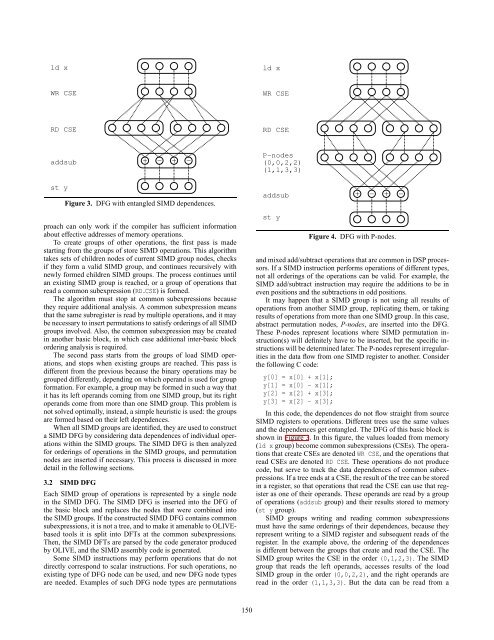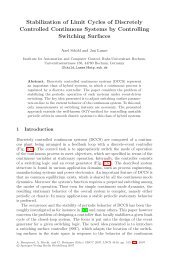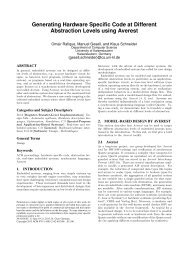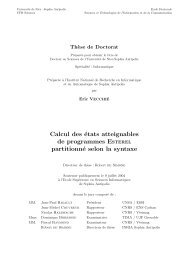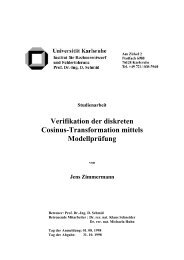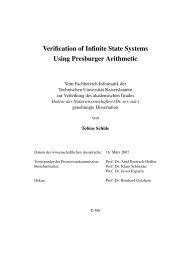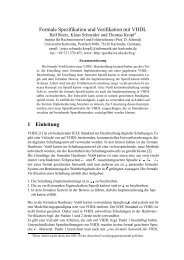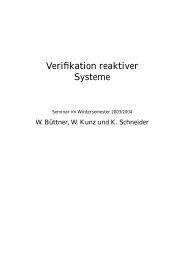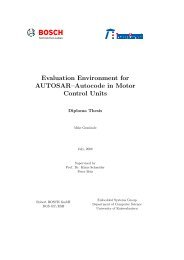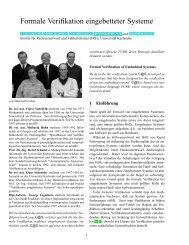Generation of permutations for {SIMD} processors - Embedded ...
Generation of permutations for {SIMD} processors - Embedded ...
Generation of permutations for {SIMD} processors - Embedded ...
Create successful ePaper yourself
Turn your PDF publications into a flip-book with our unique Google optimized e-Paper software.
ld x<br />
ld x<br />
WR CSE<br />
WR CSE<br />
RD CSE<br />
RD CSE<br />
addsub<br />
+ − + −<br />
P−nodes<br />
(0,0,2,2)<br />
(1,1,3,3)<br />
st y<br />
Figure 3. DFG with entangled <strong>SIMD</strong> dependences.<br />
proach can only work if the compiler has sufficient in<strong>for</strong>mation<br />
about effective addresses <strong>of</strong> memory operations.<br />
To create groups <strong>of</strong> other operations, the first pass is made<br />
starting from the groups <strong>of</strong> store <strong>SIMD</strong> operations. This algorithm<br />
takes sets <strong>of</strong> children nodes <strong>of</strong> current <strong>SIMD</strong> group nodes, checks<br />
if they <strong>for</strong>m a valid <strong>SIMD</strong> group, and continues recursively with<br />
newly <strong>for</strong>med children <strong>SIMD</strong> groups. The process continues until<br />
an existing <strong>SIMD</strong> group is reached, or a group <strong>of</strong> operations that<br />
read a common subexpression (RD CSE) is <strong>for</strong>med.<br />
The algorithm must stop at common subexpressions because<br />
they require additional analysis. A common subexpression means<br />
that the same subregister is read by multiple operations, and it may<br />
be necessary to insert <strong>permutations</strong> to satisfy orderings <strong>of</strong> all <strong>SIMD</strong><br />
groups involved. Also, the common subexpression may be created<br />
in another basic block, in which case additional inter-basic block<br />
ordering analysis is required.<br />
The second pass starts from the groups <strong>of</strong> load <strong>SIMD</strong> operations,<br />
and stops when existing groups are reached. This pass is<br />
different from the previous because the binary operations may be<br />
grouped differently, depending on which operand is used <strong>for</strong> group<br />
<strong>for</strong>mation. For example, a group may be <strong>for</strong>med in such a way that<br />
it has its left operands coming from one <strong>SIMD</strong> group, but its right<br />
operands come from more than one <strong>SIMD</strong> group. This problem is<br />
not solved optimally, instead, a simple heuristic is used: the groups<br />
are <strong>for</strong>med based on their left dependences.<br />
When all <strong>SIMD</strong> groups are identified, they are used to construct<br />
a <strong>SIMD</strong> DFG by considering data dependences <strong>of</strong> individual operations<br />
within the <strong>SIMD</strong> groups. The <strong>SIMD</strong> DFG is then analyzed<br />
<strong>for</strong> orderings <strong>of</strong> operations in the <strong>SIMD</strong> groups, and permutation<br />
nodes are inserted if necessary. This process is discussed in more<br />
detail in the following sections.<br />
3.2 <strong>SIMD</strong> DFG<br />
Each <strong>SIMD</strong> group <strong>of</strong> operations is represented by a single node<br />
in the <strong>SIMD</strong> DFG. The <strong>SIMD</strong> DFG is inserted into the DFG <strong>of</strong><br />
the basic block and replaces the nodes that were combined into<br />
the <strong>SIMD</strong> groups. If the constructed <strong>SIMD</strong> DFG contains common<br />
subexpressions, it is not a tree, and to make it amenable to OLIVEbased<br />
tools it is split into DFTs at the common subexpressions.<br />
Then, the <strong>SIMD</strong> DFTs are parsed by the code generator produced<br />
by OLIVE, and the <strong>SIMD</strong> assembly code is generated.<br />
Some <strong>SIMD</strong> instructions may per<strong>for</strong>m operations that do not<br />
directly correspond to scalar instructions. For such operations, no<br />
existing type <strong>of</strong> DFG node can be used, and new DFG node types<br />
are needed. Examples <strong>of</strong> such DFG node types are <strong>permutations</strong><br />
addsub<br />
st y<br />
+ − + −<br />
Figure 4. DFG with P-nodes.<br />
and mixed add/subtract operations that are common in DSP <strong>processors</strong>.<br />
If a <strong>SIMD</strong> instruction per<strong>for</strong>ms operations <strong>of</strong> different types,<br />
not all orderings <strong>of</strong> the operations can be valid. For example, the<br />
<strong>SIMD</strong> add/subtract instruction may require the additions to be in<br />
even positions and the subtractions in odd positions.<br />
It may happen that a <strong>SIMD</strong> group is not using all results <strong>of</strong><br />
operations from another <strong>SIMD</strong> group, replicating them, or taking<br />
results <strong>of</strong> operations from more than one <strong>SIMD</strong> group. In this case,<br />
abstract permutation nodes, P-nodes, are inserted into the DFG.<br />
These P-nodes represent locations where <strong>SIMD</strong> permutation instruction(s)<br />
will definitely have to be inserted, but the specific instructions<br />
will be determined later. The P-nodes represent irregularities<br />
in the data flow from one <strong>SIMD</strong> register to another. Consider<br />
the following C code:<br />
y[0] = x[0] + x[1];<br />
y[1] = x[0] - x[1];<br />
y[2] = x[2] + x[3];<br />
y[3] = x[2] - x[3];<br />
In this code, the dependences do not flow straight from source<br />
<strong>SIMD</strong> registers to operations. Different trees use the same values<br />
and the dependences get entangled. The DFG <strong>of</strong> this basic block is<br />
shown in Figure 3. In this figure, the values loaded from memory<br />
(ld x group) become common subexpressions (CSEs). The operations<br />
that create CSEs are denoted WR CSE, and the operations that<br />
read CSEs are denoted RD CSE. These operations do not produce<br />
code, but serve to track the data dependences <strong>of</strong> common subexpressions.<br />
If a tree ends at a CSE, the result <strong>of</strong> the tree can be stored<br />
in a register, so that operations that read the CSE can use that register<br />
as one <strong>of</strong> their operands. These operands are read by a group<br />
<strong>of</strong> operations (addsub group) and their results stored to memory<br />
(st y group).<br />
<strong>SIMD</strong> groups writing and reading common subexpressions<br />
must have the same orderings <strong>of</strong> their dependences, because they<br />
represent writing to a <strong>SIMD</strong> register and subsequent reads <strong>of</strong> the<br />
register. In the example above, the ordering <strong>of</strong> the dependences<br />
is different between the groups that create and read the CSE. The<br />
<strong>SIMD</strong> group writes the CSE in the order (0,1,2,3). The <strong>SIMD</strong><br />
group that reads the left operands, accesses results <strong>of</strong> the load<br />
<strong>SIMD</strong> group in the order (0,0,2,2), and the right operands are<br />
read in the order (1,1,3,3). But the data can be read from a<br />
LCTES’05, 4 2005/4/16<br />
150


